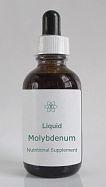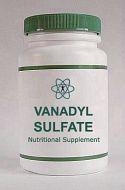Vanadium and Molybdenum
| Cellular Nutrition
Vanadium (V) and Molybdenum (Mo) are associated trace elements. While molybdenum has been classified as essential to human health, there is still controversy among some researchers regarding the essentiality of vanadium, and its value in human nutrition. When vanadium or molybdenum test below normal, most of the time - at least in developed parts of the world - it is as a result of their antagonists being too high, and less often because of insufficient dietary intake.
Chromium and copper are one of the closest associated trace element pairs, so with copper being virtually always higher than chromium, molybdenum - being a copper antagonist - is nearly as often lower than vanadium. One exception may be excessive sugar intake, which has a tendency to deplete chromium, and to a lesser extent vanadium (chromium and vanadium are also antagonists, but share similar attributes toward insulin / glucose management).
Excessive copper levels are generally found with many joint degenerative types of conditions, whereby next to sulfur-rich supplements, molybdenum and chromium can be helpful with these arthritic disorders as a result of their ability to lower copper. When molybdenum and/or vanadium levels are far below normal, there is a greater occurrence of spinal degeneration - with or without the presence of high copper, although when copper is very high also, it very likely has been a contributing factor.
Ankylosing Spondylitis is a classic example where both, molybdenum and vanadium are excessively low, and their antagonists are excessively high. In addition, calcium and magnesium are very high as well (which will have a degenerative effect when elevated), contributing to the degenerative nature of this condition:

In addition to very low molybdenum oftentimes accompanying various forms of spinal degeneration, ongoing dizziness is another factor with craniocervical disturbances, or those of the cranial ganglia, and it isn't always clear which came first - the symptoms, or the low molybdenum - unless a known injury triggered the problem. Nevertheless, if matched to the problem, Dr. Ronald Roth had seen molybdenum relieve the dizziness within a few hours following its supplementation.
To a much lesser extent the above also applies to vanadium - at least in theory. In practice, vanadium rarely becomes as deficient as molybdenum. In fact, it is very uncommon that vanadium would require supplementation at all (ankylosing spondylitis being a rare exception), because of the chemical interactions it is part of, and where molybdenum and chromium levels would both have to be much higher than vanadium.
Molybdenum is a component of xanthine oxidase, aldehyde oxidase, and sulfite oxidase, which are important enzyme systems. Xanthine oxidase is involved in converting nucleic acid to uric acid, a waste product of protein / purine metabolism, and although elevated uric acid can cause gouty attacks in prone individuals, normal uric acid levels are actually beneficial, as they have antioxidative properties and protect cells from free radicals.
Dr. Ronald Roth had not seen moderate molybdenum supplementation cause gout [1] in patients who exhibited low levels of molybdenum even when they were prone for suffering from gout attacks, however very high molybdenum intake is capable of triggering inflammatory joint disease.
Aldehyde oxidase helps in the oxidation of carbohydrates, and sulfite oxidase helps to detoxify sulfites, which used to be common food preservatives (salad bars), and which some sensitive individuals have a severe allergic reaction to. While sulfur and molybdenum compete for uptake in plants, supplementing either one in humans helps uptake of the other by inhibiting copper, which is an antagonist to sulfur and molybdenum, so for practical purposes (and confirmed in thousands of clinical applications), they work as synergists with one another. There is an identical relationship between vanadium and selenium against chromium, resulting in the same synergism.
In animal studies, Vanadium has been found to function similarly to insulin by helping to maintain blood glucose levels the same as in the control group, despite lower serum insulin, while at the same time making cell membrane insulin receptors more sensitive to insulin. In human studies, daily insulin requirements in Type I diabetics decreased by as much as 14%, and in Type II diabetics, there was an increase in insulin sensitivity observed following vanadium treatments using either vanadyl sulfate or sodium metavanadate.
So why don't doctors tell their patients to supplement vanadium in order to reduce insulin requirements? Perhaps some studies just don't compare to clinical applications in the real world. Dr. Ronald Roth's own patient feedback has not been favorable to vanadium supplementation so far for diabetes. Instead of reducing insulin requirements, blood sugar had gone up following vanadium supplementation!

Both, vanadium and molybdenum have anticarcinogenic (anti-cancer) properties in regard to breast cancer (V + Mo) in animal models, and esophageal cancer and stomach cancer (Mo) in humans, which may be due to the copper-inhibiting effect of molybdenum, or possibly by molybdenum protecting the body from nitrosamine formation as a result of consuming foods (meats or vegetables) high in nitrates or nitrites.
According to some sources, supplementing vanadium has the potential to improve athletic performance because of the anabolic effect of vanadyl sulfate being similar to insulin (supposedly resulting in higher liver and muscle glycogen stores), however the validity of that claim is not universally accepted. For individuals suffering from bipolar / manic-depressive illness, there is evidence of possible adverse effects from increased vanadium intake due to its causative or aggravating impact on reduced sodium pump activity.
Short of minimal amounts present in some multi-mineral formulations, the effects of supplementing higher amounts of vanadium (as vanadyl sulphate) on a regular basis - when not indicated - can have detrimental side effects that may include anything from various aches and pains and flu-like symptoms (partly as a result of inhibiting chromium), to eventually vanadium causing all kinds of bizarre, chemical imbalances. Supplementing higher amounts of vanadium can also cause a very noticeable green discoloration of the tongue.

 Manganese may help with some symptoms of Parkinson's disease such as muscle rigidity and twitching...
Manganese may help with some symptoms of Parkinson's disease such as muscle rigidity and twitching...
 Research shows that phytosterols such as beta-sitosterol may help normalize the function of natural killer cells and T-helper lymphocytes...
Research shows that phytosterols such as beta-sitosterol may help normalize the function of natural killer cells and T-helper lymphocytes...
 Iron deficiency may be suspect with some forms of ADHD. 84% of children with ADHD were found to have abnormally low levels of ferritin...
Iron deficiency may be suspect with some forms of ADHD. 84% of children with ADHD were found to have abnormally low levels of ferritin...
 A high intake of B Vitamins can trigger heart palpitations, HBP, major complications in patients with congestive heart disease...
A high intake of B Vitamins can trigger heart palpitations, HBP, major complications in patients with congestive heart disease...